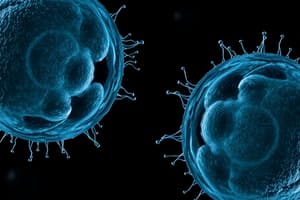Podcast
Questions and Answers
What is the primary reason for the complexity of cell division in eukaryotes?
What is the primary reason for the complexity of cell division in eukaryotes?
- Presence of a large number of ribosomes
- Presence of a cell wall
- Increased number of chromosomes, organelles and complexity (correct)
- Lack of binary fission
What is the function of the synthesis phase (S) in the cell cycle?
What is the function of the synthesis phase (S) in the cell cycle?
- Reformation of nuclei and decondensation of chromosomes
- Preparation for cell division
- Cell growth and preparation for DNA synthesis
- DNA synthesis and replication of the entire set of chromosomes (correct)
What is the process by which animal cells undergo cytokinesis?
What is the process by which animal cells undergo cytokinesis?
- Cleavage (correct)
- Binary fission
- Formation of a cell plate
- Mitosis
During which stage of mitosis do sister chromatids separate and move along the microtubules?
During which stage of mitosis do sister chromatids separate and move along the microtubules?
What percentage of the total cell cycle time is spent in interphase?
What percentage of the total cell cycle time is spent in interphase?
What is the primary function of a cell in G0 phase?
What is the primary function of a cell in G0 phase?
What is the significance of the checkpoint at the exit from mitosis?
What is the significance of the checkpoint at the exit from mitosis?
What is the role of progesterone in Xenopus laevis oocytes?
What is the role of progesterone in Xenopus laevis oocytes?
What is the importance of the regulation of the cell cycle?
What is the importance of the regulation of the cell cycle?
What is the condition of Xenopus laevis oocytes before they are induced to enter meiosis I?
What is the condition of Xenopus laevis oocytes before they are induced to enter meiosis I?
Flashcards are hidden until you start studying
Study Notes
Cell Division in Eukaryotes
- Eukaryotic cell division is more complex than prokaryotic cell division due to increased number of chromosomes, organelles, and complexity.
The Cell Cycle
- The cell cycle consists of four phases: Interphase and M-phase.
- Interphase is divided into three stages: G1 (Gap phase 1), S (Synthesis phase), and G2 (Gap phase 2).
- G1 phase: cell grows and prepares to synthesize DNA.
- S phase: DNA synthesis takes place, and the whole set of chromosomes is replicated.
- G2 phase: cell prepares for division.
- Interphase lasts for at least 91% of the total time required for the cell cycle.
The Mitotic Phase
- M phase: actual division of the original cell into two daughter cells takes place.
- M phase involves two distinct division-related processes: mitosis and cytokinesis.
- Mitosis: nuclear DNA condenses into visible chromosomes, and is pulled apart by the mitotic spindle.
- Mitosis takes place in four major stages: prophase, metaphase, anaphase, and telophase.
- Prophase: chromosome condensation takes place.
- Prometaphase-metaphase: sister chromatids attach to microtubules and align themselves at the equator.
- Anaphase: sister chromatids are separated and move along the microtubules.
- Telophase: nuclei are reformed, and chromosomes are decondensed.
- Cytokinesis: cell divides into two daughter cells.
- Animal cells: cytokinesis by cleavage.
- Plant cells: cytokinesis by cell plate formation.
Cell Cycle Regulation
- Cell cycle regulation ensures the orderly progression of events so that nuclear cycle is coordinated with cell growth and physical separation.
- Replication must occur once per cell cycle and precede chromosome segregation.
- Segregation must be complete before cytokinesis.
- The cell must know when to enter/exit the cell cycle phases.
G0 Phase
- G0 phase: a "resting" phase where the cell is not actively preparing to divide, but performs its cellular function.
- G0 phase can be permanent for some cells or temporary if the cell gets the right signals.
- A cell in G0 phase may be said to be quiescent or senescent.
Historical Background
- Xenopus laevis oocytes were used to study factors that induced mitosis and meiosis.
- Oocytes arrest in the G2 stage of the cell cycle for up to 8 months and are induced to enter meiosis I by progesterone.
- Meiosis is completed only when the nucleus is released from the second arrest following egg fertilization.
Studying That Suits You
Use AI to generate personalized quizzes and flashcards to suit your learning preferences.




